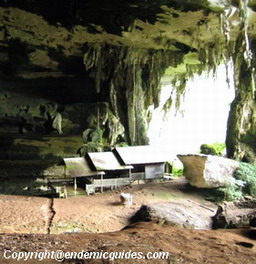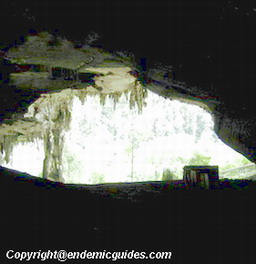|
Welcome To
GUA NIAH NP
PAGE - SARAWAK
|
From
PAGE 1 >>
FLORA AND
FAUNA

It is worth taking your time and walking quietly along the
way, as you may well see some of the park's wildlife. If you
leave the Great cave and return along the plank walk around
clouds intermingling, you can see half a million of swiftlets
are returning to their nests, whilst half a million bats fly out
to forage in the forest. This is one of Niah's most spectacular
sights which represent only a small niche in the earth complex
ecosystem. One of Niah's other notable sights is the unusual
number of luminous fungi that growth at dark night.
Colourful birds, squirrels, lizards, butterflies and all
manner of unusual insects and invertebrates are commonly seen.
Cave creature like Cave Spider, Cave Cockroaches, Cave Bats,
cave snake and frogs. If you are lucky, you may see monkeys,
flying lizards and the occasionally hornbill.
Attraction and
Activities
The Great Cave
The Great Cave as the name suggests, is an enormous cavern.
Situated approximately 3 km from the Park Office and is easily
reached via the plank walk, which is enclosed, on both sides by
dense primary rainforest. The walk alone is fascinating in its
own right, as you pass close to giant Tapang trees (Koompassia
excelsa) with their enormous buttressed roots, pandanus plants
twice the size of a person and colourful exquisitely formed
orchids and tree fungi.
The Great cave is not only important archaeological site,
where it was inhabited by man for 40,000 years, but the cave is
also full bats and birds, especially the Black-nest Swiftlets.
Locals usually collect the nests of this bird to cook birds’
nest soup.

Like other caves in Sarawak it has extremely big chambers
and passages. The cave system has eight entrances. The west
entrance, also called West Mouth, is one of the world’s most
spectacular cave entrances with over 60m high and 250m wide,
leading to an even larger chamber within. Proceeding into the
cave, the sound of disembodied voices mingles with the squeaking
of million of bats and swiftlets to create an eerie atmosphere.
The voices belong to the guano (bird and bat excrement) covering
the cave floor. The guano is then carried in sacks to the Sungai
Niah, where it is graded and sold as fertiliser.
Moon Cave
where you can see beam of sunlight shines through an opening at
the limestone roof top. After the dark section with bats you
will then reach the eastern entrance. The first significant rock
formation you reach is the Trader's Cave, which is really an
extended rock overhang rather than a cave proper. This is where
the birds nest and guano traders conduct their business, hence
name over the trader.

The Large
Chamber
The passage at the back of the Great cave leads to the large
chamber known as 'Padang' where shafts of sunlight stream down
from the large holes in the cave roof to illuminate the bizarre
rock formations in the Burnt Cave. This is another excellent
spot for taking photos. After the Padang, the cave passage
becomes pitch black and it is here that you will need the
flashlight, not only to find your way along the plank walk but
to view the extraordinary shapes and weathering effects found in
the Moon Cave.
The Painted
Cave
Painted cave are very near to Moon Cave, the plank walk
pathway through the forest leads you to the Painted Cave. Here,
you can see little spread-eagled human-like figures drawn in red
hematite watch over a gravesite where the bodies of the dead
were each laid in its own boat-shaped coffin. It probably
represents warriors and hunters and some of the animals of the
souls of the deceased on the dangerous journey to the land of
the dead. The drawings have been dated as ranging between 1AD
and 780 AD.
It is worth spending some time at the Painted Cave, even
though the burial site at the cave is far more recent than those
at the Great Cave. Nevertheless, it is no less important as it
offers a clear insight into the development of the traditional
religions of Borneo.
Birds Nest
Half million swiftlets that live in the cave and make their
nests purely from their own salivary secretions and when the
nests are cleaned and cooked, they produce the famous birds nest
soup, which is as highly regarded in Chinese cuisine as caviar
is in the West. You will notice strategically positioned bamboo
poles and ladders in the cave buried vertically. Birds nest
collector will then climb up the bamboo ladders to harvest the
birds nest. Local people have practiced this dangerous
occupation for generations who earn a living from the cave.

Treks and
Trails
Niah National
Park is a great place for jungle exploration too. The Park has
two clearly marked walking trails to ease your trekking
session. They are Jalan Bukit Kasut and Jalan Madu. Remember
to bring some supply of food before going off on one of these
trails. Apart from jungle trekking or forest exploration, you
can also choose to go on mountain climbing where you will have
the chance to scale a 400 meters of limestone
ridge.
Jalan Bukit
Kasut
This trail (green and white markings) leads to the summit of
Bukit Kasut. The 45 minutes walk passes through beautiful
primary rainforest before moving into Kerangas forest at the
foot of the hill. You will also see some fascinating cliff
vegetation clinging tenuously to life in the steep limestone
slopes. The trail is a little steep but the view at the top is
worth it, offering a sweeping panorama of the rainforest canopy.
Jalan Madu
This trail (red and white markings) sticks quite close to
the banks of the Sungai Subis, a tributary of the Sungai Niah.
It takes roughly an hour and passes through both alluvial and
peat swamp forest. There are plenty of wild orchids, bizarre
mushrooms and giant pandanus plants along the side of the trail.
Back to Page 1 >>
Tour packages to Gua Niah National Park
|